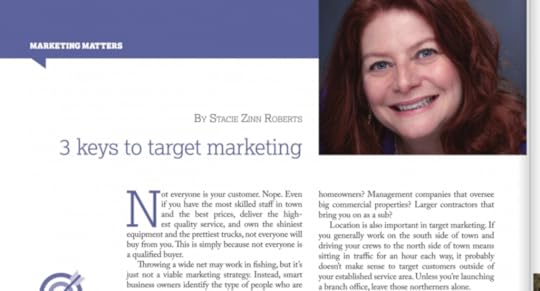Stacie Zinn Roberts's Blog, page 2
October 7, 2020
5 Website Quick Fixes
You need to fix your website. Sorry, but it’s true. Websites are finicky things. They require constant care, yet you ignore your website at your own peril. It is estimated that 75% of customers judge a company based on its website, and that’s before they ever talk to you. If your website is outdated, ugly or does not function properly, it could be costing you money. Here are five website fixes to perform now.
1. Be mobile-friendly.
Considering that studies show the majority of internet users surf the web on a mobile device, your website must be optimized to run on smartphones and tablets. This is called responsive design. Basically, your website “responds” to the size of the user’s screen. If your website is only built to be viewed on a computer monitor, mobile users will have difficulty navigating your website. To test this, grab your cell phone and visit your website. Is the navigation (Home, About, Contact, etc.) really small across the top of your screen? If so, it’s probably not responsive, which also means that it’s likely time for a website redesign.
2. Fix broken links.
Go through your website and click on all of the links, buttons or calls to action. Do they all work? If you click on a link and are directed to a page that says 404 Error or it goes to some other unintended page, it should be corrected. In addition, be sure all of your social media accounts are linked on your website using the appropriate icons (Twitter, Facebook, Instagram, etc.). Click on the icons and confirm that the links go to your account pages, not just to a Facebook login page, for example. To help keep on top of minor issues, it’s a good idea to have a web-savvy staffer or your web developer perform monthly maintenance to fix links and other issues.
3. Get secure.
About two years ago, Google Chrome (the top web browser used to surf the internet) implemented a policy that all websites have something called an SSL certificate or be flagged as “Not Secure.” Without getting too technical, the SSL certificate indicates that your site has a secure connection. Go to your website and look in the upper left corner of the URL bar where your address is. Does it say “http” or “https”? The desired address has the “https” to indicate a secure site. Do you see the words “Not Secure”? Then you don’t have an SSL certificate. Sites marked “Not Secure” serve as a warning to your customers and, frankly, makes your site look risky. Contact your website hosting company, which is the server where your site lives, commonly GoDaddy, BlueHost, HostGator, WP Engine or others. Some hosts include the SSL certificate for free or at a nominal cost. Your web developer can also do this for you and install the certificate.
4. Get up to date.
Today’s modern websites generally have an edge-to-edge design with lots of photos and sparse text. If your website design has a box around it, not many photos and reads like a dictionary, it’s likely time to redesign your website. Outdated information, photos of former employees, blog posts or news items that haven’t been updated in years also indicate a neglected website, which casts a negative impression of your company.
5. Hyperlink your email address.
If your email address is published on your website, you’re making yourself a prime target for spammers who can flood your inbox with unsavory offers and dangerous phishing emails that, when clicked, could damage your computer systems. Instead, create a contact form on your website that allows customers to send you a message. A dropdown on the form can direct emails to specific staffers. If you must have a list of emails on your site, hide them behind the word email that, when clicked, serves as a hyperlink to your email address.
I urge you to consider your website as your 24/7 salesperson on the internet who must deliver the latest information to potential customers. Take care of it. It’s that important.
Got a marketing question? I’d love to hear from you. Send me a note through my website’s contact form at: whatsyouravocado.com/contact.
Stacie Zinn Roberts is an award-winning writer, marketing expert and founder of What’s Your Avocado? Marketing and Public Relations, Mount Vernon, Washington.
This Marketing Matters column was originally published in the October 2020 issue of Irrigation & Green Industry magazine.
The post 5 Website Quick Fixes appeared first on What's Your Avocado.
September 14, 2020
How to Create an Award-Winning Marketing Campaign
What’s Your Avocado? Marketing & Public Relations Wins 5 National Writing Awards
What does it take to create award-winning marketing campaigns? Stacie Zinn Roberts, president of What’s Your Avocado? Marketing & Public Relations, based in Mount Vernon, WA, details the process she undertook to create the campaigns recently honored with five national writing awards. The honors came from the Turf & Ornamental Communicators Association (TOCA), during the organization’s annual conference, held virtually on September 11, 2020. The awards honored campaigns and writing projects that include: articles that ran in national publications featuring client’s products, copywriting for a client’s print ad, and Roberts’ Marketing Matters column that runs in a national trade publication.
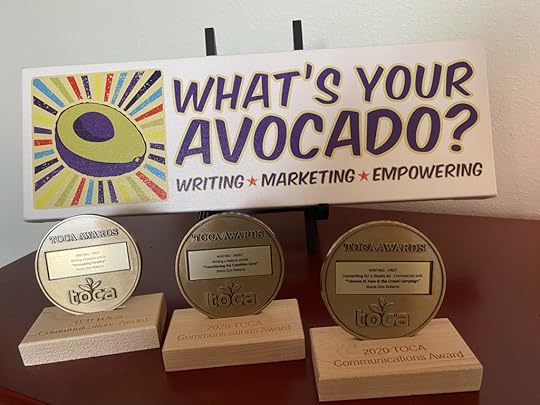
3 of the 5 awards trophies
First Place, Writing for a Display Ad, Tahoma 31 “Fans in the Crowd” – This full-page ad for client Tahoma 31 Bermudagrass, shows two golf course superintendents among a crowd of people attending a golf tournament. One turns to the other and remarks on the golf shot just played. The other remarks on how good the grass on the golf course looks. The headline “How Superintendents Watch Golf” jokes that while most folks in a tournament gallery are watching the players, superintendents only notice the grass. This concept, which speaks to Tahoma 31’s prime target audience, golf course superintendents, connected to the product’s customer in a way that spoke their language and they recognized themselves in it. See the ad here.
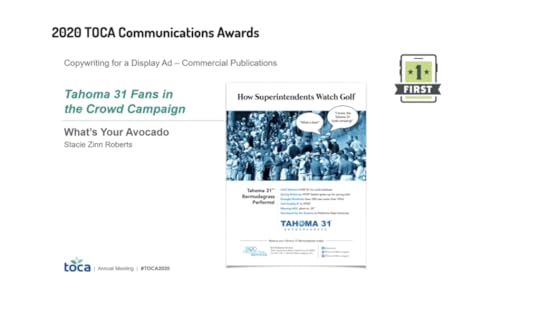
First Place, Writing a Feature Story, MarComm, “Renovating Paradise” – When I heard that Waiehu Golf Course on the island of Maui was renovating their golf course with SeaStar Seashore Paspalum turfgrass, (developed by my clients at the University of Georgia, and grown by another of my clients, Hawaiian Turfgrass), my first question was whether I could go to oversee the work? Just kidding. Kinda. But when I found out that the superintendent at this municipal golf course was doing all of the renovation work inhouse, I knew we had a newsworthy story worth telling. I structured “Renovating Paradise” as a profile of the renovation, but as the grass played a major role in the success of the project, I was able to discuss SeaStar’s benefits without being overly commercial and cover Hawaiian Turfgrass’s methodologies in an educational tone. Beautiful photos from the superintendent propelled this article to become the cover story of the September 2019 issue of Golf Course Management magazine. Read the story here.
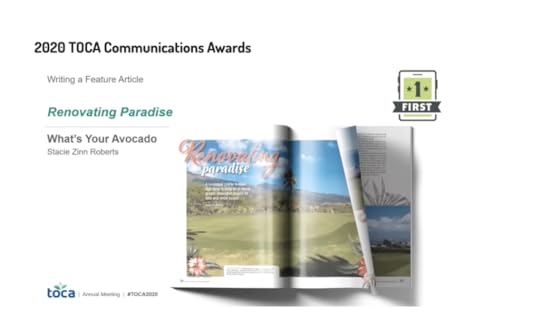
Merit Award: Writing a Feature Story, MarComm, “Transitioning the Transition Zone” – I’m proud to say I swept this category, winning both awards for Marketing Communications!! In “Transitioning the Transition Zone”, (Golf Course Management, December 2019), I had noticed a trend emerging. Due to advancements in turfgrass breeding, warm-season grasses were now being planted farther north than had been thought possible. Two of my clients, Tahoma 31 Bermudagrass, developed by Oklahoma State University, and several zoysia varieties developed by Bladerunner Farms, were leading the way in this trek northward. I knew I had scientific data, solid testimonials and access to really good photos. I pitched the story to the editor of Golf Course Management magazine and it resulted in a major feature that unveiled a trend and promoted the cold tolerance of my clients’ grasses. The response has been very positive, with lots of customer comments and buyer interest. Tahoma 31 used the article to answer cold tolerance questions in their trade show booth at the January 2020 Golf Industry Show. We’ve even had requests to test Tahoma 31 as far north as Canada, directly as a result of the credibility created by the article. Read it here.
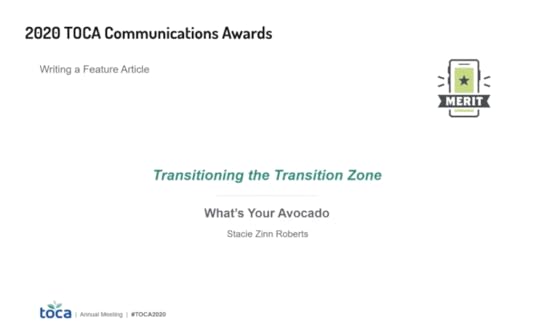
Merit Award: Writing a Feature Story, Publishing, “Renovating Paradise” – Unbeknownst to me, the editor of Golf Course Management magazine liked the article so much, he entered it on the publishing side of the competition, competing against staff writers for publications in the green industry, and it won, again!
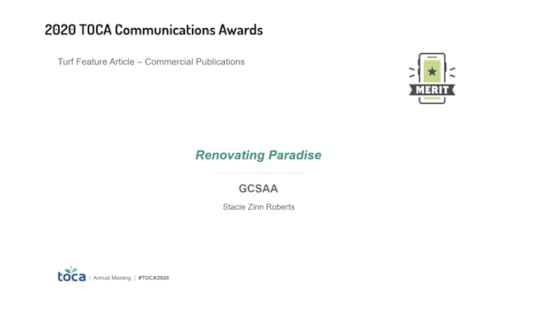
Merit Award: Writing an Editorial, “What’s Your Story?” – In December of 2019, a long-held dream of mine came true. My very first column ran in a national publication. Earlier that year, the editor of Irrigation & Green Industry magazine (the official publication of the Irrigation Association), called and asked me if I would take over the publication’s Marketing Matters column. Readers of the magazine are owners of landscaping companies and irrigation installation firms in the U.S. and worldwide. These hard-working business owners needed some guidance to market their companies. I was thrilled! My very first column served to introduce me, tell my company story, and also illustrate how two of my clients named their businesses/products. Yes, I managed to once again promote Tahoma 31 as well as Green Leaf Solutions, a high-end landscaping company in Englewood, Florida. I now write this column every other month and it is a great joy to write about actionable marketing strategies for small business owners. Read the winning column here.
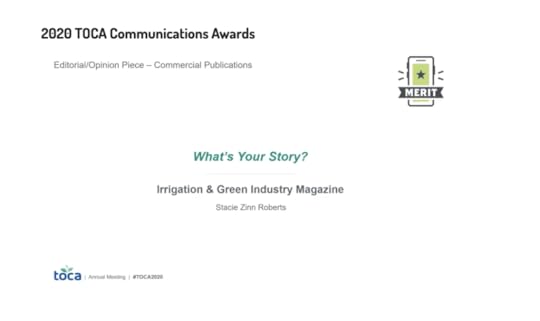
The key to creating winning campaigns, I believe, is to really understand your client’s customer base, and to develop messages that resonate with them. Write articles, blogs, ads, newsletters, whatever vehicle you choose, that offers value to the reader. Yes, deliver your marketing message, but weave it into a story that connects with the reader. Cite examples that inform, not sell. That way it’s a win-win.
ABOUT TOCA
The Turf and Ornamental Communicators Association (TOCA) is comprised of editors, writers, publishers, photographers, public relations/advertising practitioners, industry association leaders, manufacturers and others involved in green industry communications. It is a national organization based in New Prague, MN.
About What’s Your Avocado? Marketing and Public Relations
What’s Your Avocado? Marketing & Public Relations creates strategic narrative messaging, marketing, websites, graphic design, branding, public relations, and advertising campaigns for large and small businesses. The firm serves clients nationwide, with a focus on the agricultural, turf, landscape, golf and real estate industries. By the way, the Avocado? It’s the element that makes a person, product or company special. What’s Your Avocado? helps clients to find their Avocado and express it in the marketplace, thereby building a recognizable brand and a successful business. What’s Your Avocado? Marketing & Public Relations is based in Mount Vernon WA. 360-428-2878, www.whatsyouravocado.com , @whatsyouravocad
The post How to Create an Award-Winning Marketing Campaign appeared first on What's Your Avocado.
August 11, 2020
How to Create a Google My Business Account
You’ve got to make friends with Google (particularly, Google My Business,) if you want to run a successful business. A recent survey shows the average person Googles something at least three times per day, and some sources estimate it processes more than 3 billion searches every single day. Think about that. Gone are the days when anyone relied on a phone book to find a vendor. Some 275 million Americans have a smartphone in the palm of their hands, and 63% of all Google searches are initiated on mobile devices.
The most powerful tool you can harness in your marketing arsenal is Google. The first step to take in your relationship with this modern-day “Great & Powerful Oz” is its online platform called Google My Business.
What is Google My Business?
The last time you Googled a company, what happened? If you were on a desktop computer, on the left side of the screen you saw links to web pages that matched your search parameters. On the right side of the screen on the desktop, or at the top of the page on a mobile phone, did you notice the stand-alone box with the name of the business you searched? It includes a picture of the firm’s location as seen from the street and buttons to click on to visit their website or get directions. Perhaps you noticed store hours and a phone number to call? It was pretty handy, wasn’t it? That, my friends, was a Google My Business listing.
Google My Business is Google’s replacement for the phonebook. Not only that, your listing impacts how your business appears on Google Search and Google Maps. Part directory, part social media platform, Google My Business allows business owners to capture the attention of potential customers long before they visit your website. In fact, if someone Googles you, a certain percentage of customers won’t even click through to your website if your Google My Business listing is complete. They can get directions to your location or even call you from right there.
Customer convenience is just one reason to create a Google My Business listing. Information provided by Google itself states that one way to improve your local ranking on Google is to have a complete Google My Business listing. Considering that a Google My Business listing is free, there’s just no reason not to take the time to create it.
Setting up your listing
Even though Google sometimes seems like Big Brother, Google doesn’t actually know everything. A Google My Business listing doesn’t magically appear. You’ve got to set it up.
• Visit: business.google.com
• Sign in to your Google Account, or create one.
Be sure to sign up with your business email domain (example: JoeSmith@SmithLandscaping.com), not your personal email.
• Google will walk you through the steps to verify that you are the business owner. In most cases, Google will mail a physical postcard with instructions to complete the registration.
Optimize your listing
The best Google My Business listings have useful content that is updated regularly. Write a short description of your company along with descriptions of key products or services. Collect photos of your location, job sites and finished projects. You’ll add these to make your listing more robust.
Once you’re up and running, your Google My Business listing becomes the space where customers can leave Google reviews of your business and ask questions. Download the Google My Business app for your phone so that you can quickly reply to questions and thank folks for their reviews. If possible, continue to post photos as you might on your other social media pages, and update the listing for any changes in hours, services or products, because Google rewards businesses with higher search rankings when they do.
Even if you set it and forget it, you will reap the benefits when customers look for you online. I’d advise you, however, to nurture this relationship. Revisit your listing, add photos, update your office hours on holidays and reply quickly whenever anyone leaves a review. Go ahead and make friends with Google today!
If you need help setting up your Google My Business account, we’ll be happy to help. Send us a message here.
This article originally ran in the August 2020 issue of Irrigation & Green Industry magazine.
The post How to Create a Google My Business Account appeared first on What's Your Avocado.
July 28, 2020
How Avocados & Marketing Go Together
In celebration of National Avocado Day, dip a chip into your guacamole, smear your avocado toast and raise an avocado smoothie glass in honor of our favorite fruit! At What’s Your Avocado? Marketing & Public Relations, we wholeheartedly embrace this festive day honoring the epitome of yummy green goodness. But it’s not just the flavor or the health benefits that drive our avocado passion. Here in What’s Your Avocado? Land, the avocado has a deeper meaning. It’s all about authenticity in marketing.
What fuels our enthusiasm for this now trendiest of foods is the What’s Your Avocado? Marketing Concept. It’s the marketing premise that every person, every product, every company has something about them that’s special. We call that unique, special element your Avocado. When we work with our clients to help them to define their Avocado, and express that in the marketplace through marketing, branding, advertising, web design, and digital platforms, they stand a better chance of being successful because they’re operating and marketing from a place of authenticity. People do business with companies with well-defined core values that add meaning, or tell a story they can relate to. Connection with customers begins with a brand story. And a brand story begins when you understand your Avocado.
The Origin of the What’s Your Avocado? Marketing Concept
It all started about a decade ago, during a time when I was at a crossroads in my life. Contemplating my next steps, I had a dream that would forever change my focus and direction.
In the dream, I was talking to a business friend who was heavily invested in agriculture. He raised cattle, he owned citrus groves, he grew turf for golf courses. And in the dream, he was telling me that the bottom had fallen on prices for the cattle, for oranges, even for golf grass. But then he stopped lamenting and leaned in close, as if to tell me a secret. He had a twinkle in his eye. A whisper in his voice. He said that on a lark, some years ago, he had planted a grove of avocados. It was really just something he did for fun, without any expectation of profit. In the dream, he said that all of a sudden, avocados were selling for record prices, 10 times more than they ever had before. “The avocado,” he said, “the thing I’d completely overlooked, this is the thing that’s going to save me.”
And I woke up. I sat bolt upright in bed. I wondered, should I call my friend and tell him to plant some avocados? But I paused. Something held me back.

Later in the day, I was on the phone with my mother. I remember this quite distinctly, that I was standing at my kitchen sink. I was looking out the window at an orange tree heavy with sweet fruit. (I lived in Florida at the time.) And I was telling her about the dream.
As I wondered aloud if I should call my friend and tell him about the avocados, the “Ah-ha!” moment arrived. It hit me hard. I caught my breath.
I realized that the thing that would save me, the thing I’d overlooked, the avocado, wasn’t for him. It was for me. At that moment, all of the questions I’d had about my life, my goals, my mission, became clear. I realized my passion for marketing was where I should place my focus. I understood my Avocado. And I decided to share it with the world.
How to Apply the What’s Your Avocado? Marketing Concept to Your Business
A few years later, in September 2012, I launched What’s Your Avocado? Marketing & Public Relations. My goal was to translate the realization I gained from the dream into an actionable concept to help others define their core beliefs, goals, and purpose. Along with my team, I do this in three basic steps.
Step 1: Define Your Avocado
Every person, every product, every business truly does have something about them that’s special. Sometimes it’s obvious. Sometimes you have to dig for it. To begin the process, I give all of our clients the What’s Your Avocado? Workbook. (Follow this link to download a free copy.) This workbook contains a set of questions to help you to brainstorm about your company, your goals, and your product benefits, but also your reasons for undertaking this endeavor and why your customers should care.
It’s best to spend some time with the workbook. Avoid one word or short answers. Write out long paragraphs, really explore what it is that drives you to do this work or sell this product above all others.
Sometimes it’s not the product or company at all, but your own personal history that gives you a unique perspective to bring to a certain service, ignites the desire to do a certain kind of work or manufacture a certain product. Or maybe there’s a history associated with the property or community in which the business operates. You’ll start to see a pattern emerge. Follow it. In that process, you’ll uncover your Avocado.
Step 2: Develop Your Brand
Once we know what makes your vision for a product, service, or company unique, we build a brand around that vision. We create a brand story that explains the passion, the history, or the unique personal perspective that only you can bring to this line of work.
Tell that story.
We write out the story for our clients. The brand story becomes the messaging from which all other marketing stems. It’s used as the About Us on their websites, the story they tell their customers as to why their company is worth doing business with, and it’s shared with staff members to help them understand the core of what makes this company or product great.
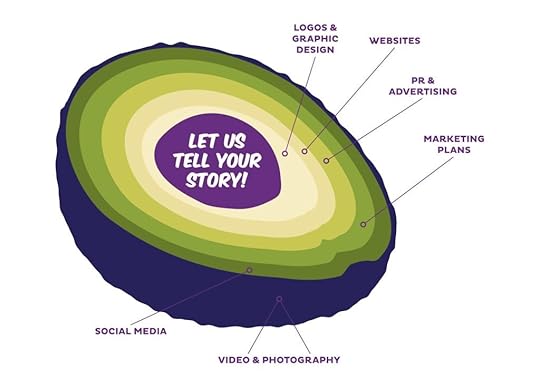
Step 3. Create Materials to Support the Brand Story
Once you’ve identified your Avocado and created the brand story, the next step is to develop the logo and other materials that visually convey the brand. The brand’s visual identity, the actual colors you choose for the logo and overall brand strategy, must tell a story.
Every choice should support your brand story. Visuals play an equal role in telling that story. Your brand should visually convey, if not what you do, then how you want your customers to feel about it. It’s critical to consider your target audience, your ideal customer, and what would appeal to them. It’s not enough that you like the brand. It has to make sense to your customer.
Your logo, your brand colors, your website, brochures, business cards, apparel, fleet vehicles, signage, and promotional items should all reflect and adhere to your brand standards and support the brand story.
Want to learn more? Download the What’s Your Avocado? Workbook and experiment with the process. Or, for a deeper dive, order your copy of the book How to Live Your Passion & Fulfill Your Dreams, which discusses more ways to get in touch with your Avocado. It also features interviews with successful people who share their Avocado stories.
If you’d like help in defining your Avocado, developing your brand story, or branding your business, feel free to contact me at https://whatsyouravocado.com/contact/.
The post How Avocados & Marketing Go Together appeared first on What's Your Avocado.
June 9, 2020
COVID-19: Marketing Through the Crisis
Craft your marketing message
Your customers want to hear from you. They’ve got questions about how this new normal impacts the services you provide. It’s your job to get them the information they need in clear, concise language.
Open for business. Are you working? Let your customers know. Create messaging that reflects if you’re open, or not, and any changes to hours or routines. If you’ve got regular customers on a regular schedule rotation, be sure they know when their service will resume.
Changes to service. Are you performing the same services? Have you devised new services during the pandemic downtime that complements or enriches your previous offerings? Are there new, creative options you can offer to help your customers?
Special COVID-19 accommodations. If there are still restrictions in place in your region, how are you and your crews practicing social distancing and equipment cleaning that customers need to know about? Have you created new online billing systems that limit in-person contact?
Adopt a grateful tone. If you’re ecstatic to be back to work, it’s OK to tell your customers you missed working with them. Thank them for their loyalty and project a hopeful tone for the future. We all need some reassurance right now. A bit of humanity in a crisis goes a long way. Consider this experience as an opportunity to build stronger relationships with your customers as we all try to connect in more authentic ways.
Where to deliver your message
Once you know what you want to say, there are many outlets for your messaging. Consider multiple outlets to reach both current and potential new customers.
Website. Consider posting updates on your website homepage or blog. Many companies have created COVID-19 pages on their websites to address coronavirus-related questions.
Email. If you’ve got a customer database, use it. Email marketing platforms like MailChimp and Constant Contact allow you to upload your database to send professional emails and track email opens. These programs offer free or low-cost email templates that make your emails look like digital newsletters. Create a link in the email that links to the COVID-19 info on your website.
Social media. If you’ve already established a business page on Facebook, Instagram, Twitter or LinkedIn, post your messaging on these platforms. Always include a link back to your company website to drive traffic there.
Digital advertising. Paid ads on Facebook and Google Ads can be relatively inexpensive, and they allow you to target your service area and customer demographics.
Direct mail. If you mail out invoices, include information in these envelopes. To reach new potential customers, postcards are can be cost-effective, if targeted at your main customer audiences.
Phone. Don’t forget the phone. If time allows, calling key customers to offer reassurance and to confirm a restart of your services provides a personal touch.
Before you send anything out, remember to use a spell-checker, and have someone else read your message before you send it to check for clarity, typos and grammar. Need help? I’d love to hear from you.
Stacie Zinn Roberts is an award-winning writer, marketing expert and founder of What’s Your Avocado? Marketing and Public Relations, Mount Vernon, Washington, which specializes in marketing content & strategy. She can be reached at stacie@whatsyouravocado.com.
This article originally ran in the Marketing Matters column written by Stacie Zinn Roberts in the June 2020 issue of Irrigation & Green Industry magazine.
The post COVID-19: Marketing Through the Crisis appeared first on What's Your Avocado.
May 26, 2020
What is Branding? And Why is a Brand Critical to Launching a Successful New Business
Branding is critical to launching a successful new business. What you name your company, the logo you use, your website, and all of your messaging, should tell a story in order to set your company apart from the competition. Gone are the days when you could slap together a name like ABC Company or XYZ Consulting in black letters on a white business card and expect customers to beat a path to your door. Customers are far too savvy for that. They expect a level of expertise and professionalism. They want to understand your reason for being, your ethics, your passion for your work. The right brand conveys what you do, why you do it, and what makes your company, products, or services special. A complete marketing strategy based on a strong brand is the cornerstone of any successful business.
What is a Brand?
A brand can be defined as the public’s overall perception of your company, product, or services. It’s important that you create your brand because if you don’t, the customer will create his own impression of you all by himself. Why leave something so crucial up to chance? Branding is the process by which you create your brand, formulate your story, and express it in the marketplace. Branding is demonstrated through every bit of messaging you create. It’s a comprehensive story told through your logo, website, printed materials, and advertising, as well as how your employees talk about your company or product, your office, your company vehicles, and your activities or sponsorships. Whatever actions you take to promote your company or product must be “on brand”, meaning they must be in line with the established persona you have created for your company, products, services and even, yourself.
How to Create a Brand
The first step in branding is to get a firm understanding of what your company is about. To do this, we always begin by asking our clients to fill out our What’s Your Avocado? Branding Workbook. This workbook leads business owners through a series of questions that drill down and help you define what you do, why you do it, and how your company is doing it differently than all other companies out there. It asks more than just what your product or service offers, but also the “why” behind the business. The questions help you to explore how you want customers to feel about your product or service, and how working with you or buying your product will be of benefit to your customers.
The workbook stems from the What’s Your Avocado? Marketing Concept that asserts that every business and every product has something about them that’s special. We call that unique element, Your Avocado. When you find Your Avocado, and express it in the marketplace, you’re being authentic. Customers are drawn to authenticity. They love a good story. They want to do business with companies that do more than just make or sell something. They want purpose, not just product. Branding is how you do that.
Branding Case Study: Wardroom Success Strategies

When Kevin Meenaghan decided to launch his leadership & team coaching business, he came to What’s Your Avocado? Marketing & PR with a strong sense of what he wanted his company to do, but was unsure how to market his new firm. Many firms in his category often resort to naming their companies after themselves. But we told Kevin that there was no way we’d let him name his company Kevin Meenaghan Consulting. Nope. Not gonna happen
Why? Because Kevin’s story is just too compelling to ignore. His brand had to reflect his diverse and truly remarkable personal history that makes the work he does so unique. You see, Kevin spent more than two decades in the military as a Navy pilot. He landed EA-6B and F-18 jets on aircraft carriers. Whoa. And when he wasn’t doing that, he was orchestrating the movement of hundreds of sailors on deck as planes took off and landed. Then, once he retired from the Navy, Kevin took his leadership skills and became an adjunct professor for a local college, as well as a guest lecturer at some of the most prestigious universities in the Pacific Northwest. Now, through his new consultancy, Kevin offers leadership training to big corporations, small firms and non-profits to help their staff and board-of-directors learn how to work together to achieve a common goal. His brand had to tell that story.
Working with What’s Your Avocado? Marketing & PR, Kevin went through our branding process to create a brand that is unique, tells his story, lets his customers know there’s a depth to his work that some ABC/XYZ consultancy could never offer. In early 2020, Kevin launched Wardroom Success Strategies.
Here is his Brand Story:
The Wardroom onboard a Navy vessel is the private room for higher-ranking officers, a place where those in management positions gather to rest, take meals, and discuss matters. In the Wardroom, leadership is nurtured and camaraderie grows. Founded by Kevin Meenaghan, a former Navy pilot and officer, Wardroom Success Strategies offers professional organizations The Wardroom Experience through methodologies that foster leadership, build teams, and deliver stronger professional cultures.
We created a color palette and font standards for Kevin that give a feeling of his strength and enthusiasm for his work. The Wardroom Success Strategies logo depicts a wardroom table with one seat pulled out to invite a prospective customer to take a seat. We created messaging that helps define his brand—taglines and all of the content on his website, wardroomsuccess.com, as well as a business card for him to hand out at events.
“I cannot overstate the importance of a dedicated branding process. Having an amazing branding & marketing expert to help – someone like Stacie and her team at What’s Your Avocado? Marketing & PR – makes the process smooth and fun, with a meaningful and effective outcome. My business name, coupled with the logo, fonts, colors, etc., are something about which I’m very proud and comfortable sharing with everyone!” said Kevin Meenaghan. “Branding also sets me and my business apart from any other company doing something similar to me. The name, logo, and brand, tied to my personal story, make me stand out!”
Kevin said his brand does exactly what he’d hoped it would do. It opens doors to projects and sales.
“When I tell people about my business name, they are usually not familiar with the meaning, and they will either tell me, or get that funny look on their face. That gives me the AMAZING opportunity to tell them about me and my business. Then, they get really interested!”
When you create a brand for your company, it should be memorable. It should start a conversation with your intended audience, and it should create interest in the special skills, history, or benefits only you can offer.
What does your brand say about you?
If you’d like to create a new brand for your company, or refresh your existing brand to better tell your story, please contact us at stacie@whatsyouravocado.com or 360-428-2878, @whatsyouravocad
Written by: Stacie Zinn Roberts, an award-winning marketing expert, Marketing Matters columnist, and president of What’s Your Avocado? Marketing & Public Relations.
The post What is Branding? And Why is a Brand Critical to Launching a Successful New Business appeared first on What's Your Avocado.
April 11, 2020
3 Keys to Target Marketing
Not everyone is your customer. Nope. Even if you have the most skilled staff in town and the best prices, deliver the highest quality service, and own the shiniest equipment and the prettiest trucks, not everyone will buy from you. This is simply because not everyone is a qualified buyer.
Throwing a wide net may work in fishing, but it’s just not a viable marketing strategy. Instead, smart business owners identify the type of people who are their best customers and focus on marketing to them. We call this target marketing. You target your messages to the group of consumers who are most likely to buy from you. Paying to advertise to anyone outside of your target audience is a waste of your hardearned money.
So why are you still marketing to everyone instead of only to your ideal customer? Here are the three keys to target marketing:
Key 1: Identify your target customers
Define the attributes and the demographics of the group of your most qualified buyers and target your efforts toward reaching that group. What does that look like? Consider if you were selling chewing gum; your target audience would most likely be teenagers, not older folks with dentures. If you were selling BMWs, your target audience would most likely be wealthy professionals older than 35, not 16-yearolds scraping money together for their first car. And since most of the readers of this magazine are selling landscape and irrigation services, your target audience is likely homeowners, not apartment dwellers who don’t have lawns of their own. A big mistake in our industry would be marketing to individual condo owners when it’s the management company that makes the vendor decisions for the homeowners association.
The best way to identify your target market is to look at your existing customer list. How would you describe the type of customer who currently buys from you? What do they have in common? Are they homeowners? Management companies that oversee big commercial properties? Larger contractors that bring you on as a sub?
Location is also important in target marketing. If you generally work on the south side of town and driving your crews to the north side of town means sitting in traffic for an hour each way, it probably doesn’t make sense to target customers outside of your established service area. Unless you’re launching a branch office, leave those northerners alone.
Key 2: Craft an effective message they need to hear
Think about who you are talking to in your marketing message. Use terminology they will understand.
Homeowners will be lost if you start talking about irrigation distribution uniformity and infiltration rates. Instead, tell them you’ll help them save water, save money or get back their free time if you do the landscape work for them. Make sense? Don’t spin a long story for commercial customers who want just the facts and your price in a succinct manner. Tell them what they need to hear, not necessarily what you want to tell them.
Key 3: Speak where they’ll hear it
Deliver your message through a medium where your target audience is likely to receive it. Be strategic about where you pay to put your marketing message. It might make you feel good to sponsor your child’s baseball team, and that’s valid, but don’t expect that sponsorship to help you win your next big commercial account. Maximize your dollars by advertising in publications that your target audience reads, exhibiting at trade shows that your target customer group attends or distributing flyers in the neighborhoods where you want to work.
If you follow these steps and spend your marketing dollar on the folks most likely to buy from you, you’ll have a better shot at meeting your revenue targets this year.
THIS ARTICLE WAS ORIGINALLY PUBLISHED IN THE APRIL 2020 ISSUE OF IRRIGATION & GREEN INDUSTRY. READ THE FULL STORY HERE
The post 3 Keys to Target Marketing appeared first on What's Your Avocado.
April 4, 2020
How to Look More Professional on Zoom Calls & Videos: Get a Virtual Image Makeover
A few weeks ago, I recorded a video. I wanted to get some information out about how business owners should craft their messaging regarding the Coronavirus. I was in a hurry and I didn’t think about what the video should look like. All I was really concerned about was getting that information out right away. Big mistake.
Poor Video Quality Diminishes the Message
When I shot the video, I thought the messaging was really good. It was important information. Unfortunately, the video looked awful. The lighting was poor with weird shadows across my face, the audio was echoing and I was pressed flat against a wall. But because I was in a hurry, I went ahead and put it out on YouTube. and send it to clients.
I should not have done that, and I knew it. Because no matter how good the information, if you’re shooing a video, people are looking at it. The image must support the message, not take away from it.
Virtual Image Makeover
A friend of mine, Rebecca Murray, is a terrific videographer and photographer with whom I frequently partner to produce stunning images for my clients.
Along with being very talented, Rebecca is kind of diplomatically critical, let’s put it that way.
I knew as soon as I put that video out that I was going to get a call from her about how poor my video quality was. So, on a Sunday morning, the phone rang and it was Rebecca.
She tried very hard to be kind, but I knew for sure why she was calling. I saved her the trouble and I owned up to it. Rather than scold me, she offered to help me with a Virtual Image Makeover.
Some of the elements considered in the Virtual Image Makeover were:
Lighting
Items in camera view in the space behind me
Audio quality
Camera quality
The consultation took place over Zoom video chat so that she could see what a video audience would see, and also to practice social distancing. It took less than an hour and truly painless.
The Result
After the Virtual Image Makeover, my videos and Zoom meetings just look better. I didn’t expect to look like a supermodel, because, well, I don’t look like a supermodel. I look like a better version of myself on the video, which is what I wanted.
Your virtual image is specifically important right now because video is how we’re doing business. With social distancing, this is how we’re seeing each other. We can’t meet with people in person, we have to do it by video, and you want to present a good impression when you’re working with clients and colleagues. You want to look like you’re actually working from home, not lounging in sweatpants.
A Virtual Image Makeover consultation can give you the confidence that when you are on camera doing your work, that you look as professional as you sound.
I’d honestly like to save you from making the same mistake I made. I was embarrassed. I put out something that was a lesser product. And I knew better.
I thought that if I shared my “oops” moment with you, I could make up for it, and help you in the process.
To schedule a Virtual Image Makeover, contact Rebecca Murray at Skagit Media Marketing, rebecca@skagitmediamarketing.com
Should you need messaging help or marketing strategy, please contact me, Stacie Zinn Roberts, at What’s Your Avocado? Marketing & Public Relations, stacie@whatsyouravocado.com
I look forward to the day when we can meet again in person. But until then, take care of yourself and take care of your virtual image.
The post How to Look More Professional on Zoom Calls & Videos: Get a Virtual Image Makeover appeared first on What's Your Avocado.
March 24, 2020
Coronavirus (COVID-19) – Small Business Tips for Communications with Customers During the Outbreak
I’m Stacie Zinn Roberts with What’s Your Avocado? Marketing and PR. I’m reaching out to you today to talk to you about your crisis communications during the Coronavirus outbreak. This is an absolutely unprecedented event and it’s impacting every type of business and every person in the country and around the world. So what do we do? We need to continue to talk to each other. We hope that we can sustain so that we keep our businesses going. This will be over at some point and we want to also be in business when it is over.
Be Honest
So first of all, we need to be kind to one another because this is very, very stressful. As a business person, it’s really important that you are in communication with your customers. Let them know what’s going on. You need to send your messaging out through e-mail and social media, wherever else you can communicate with your customers, but those are the main ways. And when you do that, make sure that first and foremost you tell your customers that you’re reaching out to them. that this is a communication about the Coronavirus. The best thing to say is that this is a Coronavirus Update. I’ve been watching lots of crisis communications lately. I’m getting e-mails from all different types of industry sectors.
I saw one that was so disingenuous that I have to warn you against doing this. The subject field said, “We are Happy and Healthy!”
That was just terrible. It’s dishonest. It’s unkind and it’s unwise. Just be straightforward and honest with your customers. Make the subject or headline “Coronavirus Update” or. “Coronavirus Update from the CEO”, something to that effect. Be straightforward.
Clarify Hours, Contact Info, Services
Tell your customers if you are open for business. Lots of businesses have been shut down, have to reschedule appointments, or are restaurants offering takeout out. Let your customers know in what capacity you are still operating. If your business is closed and your staff is working from home, let your customers know how to reach you. You may have a voice mail service that you can’t access remotely, for instance. Let people know not to leave you a voicemail. Let them know that the best way to reach you is by email, or phone, or your cell phone. Publish a list of how to get in touch with you and your staff. You’ll also want to explain any new services that you can offer, anything that would be helpful and just be kind.
Be Human
Let your customers know how you’re feeling about this, that we were all in this together, and whatever expertise you can share, that would be helpful. And actually, that’s why I’m doing this video. I, of course, do crisis communications. I have written these letters and helped my clients. And if you need help with that, terrific. But that’s not why I’m doing this. I think we should all just share what we know in uncertain times and help each other. If you want to reach me, I’m at stacie@whatsyouravocado.com. My voicemail is 360-428-2878. Our website is whatyouravocado.com But honestly, just take care of each other. Talk to your customers. Be a human being. Be kind. And we’ll get through it together. Thanks.
The post Coronavirus (COVID-19) – Small Business Tips for Communications with Customers During the Outbreak appeared first on What's Your Avocado.
February 17, 2020
5 Tips for Better Emails
I work with this vendor named Darryl. Darryl is a nice guy. His products are well-priced. They’re good quality. Everything comes in on time. But Darryl is hard to work with because Darryl is terrible at email. Every time I work with him, he signs his email: “Thanks, Darryl.” Darryl knows his phone number. I don’t. Nearly every time I buy something from him, I need to call him. But because his signature doesn’t have his phone number, and I don’t have it memorized, I’ve got to go searching for it. It creates extra work for me. It’s annoying. Don’t be Darryl.
I tell you this story because most people, like Darryl, don’t realize they are terrible at email. But you, my friend, can get better at email, and your customers will thank you for it. Here’s how:
Create a complete signature.
Don’t assume that your customers know you or anything about you. Always include your name, title, company name, address, phone number and email address. Add a link to your website and all of your social media channels too. To do this, create a standard email signature in your email software that automatically populates on the bottom of every email.
If this seems like overkill, consider the information you’re actually conveying. Using your full name lets the receiver know who you are. Maybe there are two men named Bob at your company. Your full name tells them you’re the right Bob. Your title tells the recipient that you are qualified to answer their questions. Your company name tells them who you represent. The address indicates if you are local to your customers. It gives them a clue to your time zone if you’re not local and a physical address in case they want to drop by with a basket of fruit. You never know! Include your phone number, so they can call you, and your email address, so they don’t have to look for it in the email thread. And the rest offers a myriad of ways to contact you, learn about your company and become a raving fan.
Keep it short.
Have you ever opened an email and found it went on, and on and on? I bet you didn’t read the whole thing. Just skimmed it, right? We’re all busy and no one has time to read the War and Peace of emails. It’s just too daunting. So do your customers a favor, and keep it short. Get to the point in three paragraphs or less. Say thank you and end it.
Use subheads and bullets.
If you can’t keep it short, then use subheads and bullets to break up the information and call out statistics, dates or other important bits of information.
They might only read the bullets because most of us know that’s where the good stuff is. Vary the length of paragraphs to create white space, make it easier to read and pull the reader’s eye through the email.
Make friends with spell-check.
Most email programs come with a spell-checker. In addition, there are several spell-check programs available for download. Grammarly offers free and paid versions (www.grammarly.com) that work as a Chrome extension to your email. I use them together to double-check my spelling.
Don’t type in ALL CAPS.
In the world of email, ALL CAPS is the equivalent of screaming at the email recipient. Not only is it rude, but a long string of capitalized words is almost impossible to read. Use ALL CAPS sparingly, for emphasis only, or NOT AT ALL because it sounds like your mom is scolding you.
Every email you send is a representation of you and your company. It’s marketing in its purest form. Make it easy for your clients and potential customers to do business with you. Follow these tips, then shoot me an email at stacie@whatsyouravocado.com to let me know about your progress.
This article originally ran in the February 2020 issue of Irrigation & Green Industry magazine, Marketing Matters column by Stacie Zinn Roberts.
The post 5 Tips for Better Emails appeared first on What's Your Avocado.

